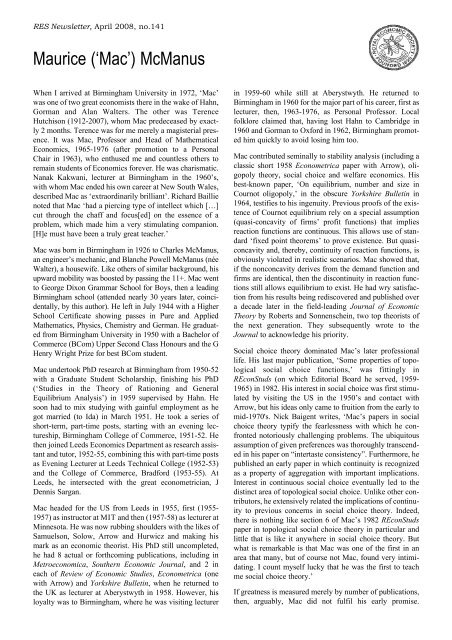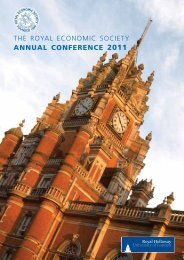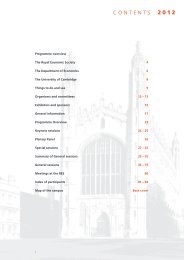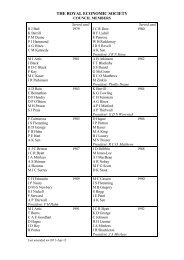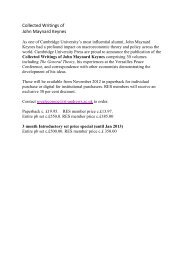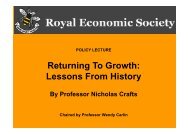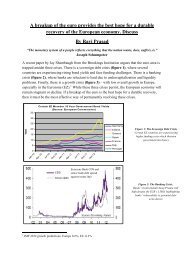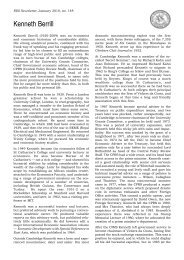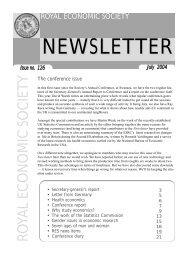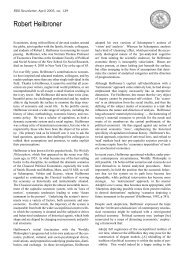Maurice ('Mac') McManus
Maurice ('Mac') McManus
Maurice ('Mac') McManus
You also want an ePaper? Increase the reach of your titles
YUMPU automatically turns print PDFs into web optimized ePapers that Google loves.
RES Newsletter, April 2008, no.141<br />
<strong>Maurice</strong> (‘Mac’) <strong>McManus</strong><br />
When I arrived at Birmingham University in 1972, ‘Mac’<br />
was one of two great economists there in the wake of Hahn,<br />
Gorman and Alan Walters. The other was Terence<br />
Hutchison (1912-2007), whom Mac predeceased by exactly<br />
2 months. Terence was for me merely a magisterial presence.<br />
It was Mac, Professor and Head of Mathematical<br />
Economics, 1965-1976 (after promotion to a Personal<br />
Chair in 1963), who enthused me and countless others to<br />
remain students of Economics forever. He was charismatic.<br />
Nanak Kakwani, lecturer at Birmingham in the 1960’s,<br />
with whom Mac ended his own career at New South Wales,<br />
described Mac as ‘extraordinarily brilliant’. Richard Baillie<br />
noted that Mac ‘had a piercing type of intellect which […]<br />
cut through the chaff and focus[ed] on the essence of a<br />
problem, which made him a very stimulating companion.<br />
[H]e must have been a truly great teacher.’<br />
Mac was born in Birmingham in 1926 to Charles <strong>McManus</strong>,<br />
an engineer’s mechanic, and Blanche Powell <strong>McManus</strong> (née<br />
Walter), a housewife. Like others of similar background, his<br />
upward mobility was boosted by passing the 11+. Mac went<br />
to George Dixon Grammar School for Boys, then a leading<br />
Birmingham school (attended nearly 30 years later, coincidentally,<br />
by this author). He left in July 1944 with a Higher<br />
School Certificate showing passes in Pure and Applied<br />
Mathematics, Physics, Chemistry and German. He graduated<br />
from Birmingham University in 1950 with a Bachelor of<br />
Commerce (BCom) Upper Second Class Honours and the G<br />
Henry Wright Prize for best BCom student.<br />
Mac undertook PhD research at Birmingham from 1950-52<br />
with a Graduate Student Scholarship, finishing his PhD<br />
(‘Studies in the Theory of Rationing and General<br />
Equilibrium Analysis’) in 1959 supervised by Hahn. He<br />
soon had to mix studying with gainful employment as he<br />
got married (to Ida) in March 1951. He took a series of<br />
short-term, part-time posts, starting with an evening lectureship,<br />
Birmingham College of Commerce, 1951-52. He<br />
then joined Leeds Economics Department as research assistant<br />
and tutor, 1952-55, combining this with part-time posts<br />
as Evening Lecturer at Leeds Technical College (1952-53)<br />
and the College of Commerce, Bradford (1953-55). At<br />
Leeds, he intersected with the great econometrician, J<br />
Dennis Sargan.<br />
Mac headed for the US from Leeds in 1955, first (1955-<br />
1957) as instructor at MIT and then (1957-58) as lecturer at<br />
Minnesota. He was now rubbing shoulders with the likes of<br />
Samuelson, Solow, Arrow and Hurwicz and making his<br />
mark as an economic theorist. His PhD still uncompleted,<br />
he had 8 actual or forthcoming publications, including in<br />
Metroeconomica, Southern Economic Journal, and 2 in<br />
each of Review of Economic Studies, Econometrica (one<br />
with Arrow) and Yorkshire Bulletin, when he returned to<br />
the UK as lecturer at Aberystwyth in 1958. However, his<br />
loyalty was to Birmingham, where he was visiting lecturer<br />
in 1959-60 while still at Aberystwyth. He returned to<br />
Birmingham in 1960 for the major part of his career, first as<br />
lecturer, then, 1963-1976, as Personal Professor. Local<br />
folklore claimed that, having lost Hahn to Cambridge in<br />
1960 and Gorman to Oxford in 1962, Birmingham promoted<br />
him quickly to avoid losing him too.<br />
Mac contributed seminally to stability analysis (including a<br />
classic short 1958 Econometrica paper with Arrow), oligopoly<br />
theory, social choice and welfare economics. His<br />
best-known paper, ‘On equilibrium, number and size in<br />
Cournot oligopoly,’ in the obscure Yorkshire Bulletin in<br />
1964, testifies to his ingenuity. Previous proofs of the existence<br />
of Cournot equilibrium rely on a special assumption<br />
(quasi-concavity of firms’ profit functions) that implies<br />
reaction functions are continuous. This allows use of standard<br />
‘fixed point theorems’ to prove existence. But quasiconcavity<br />
and, thereby, continuity of reaction functions, is<br />
obviously violated in realistic scenarios. Mac showed that,<br />
if the nonconcavity derives from the demand function and<br />
firms are identical, then the discontinuity in reaction functions<br />
still allows equilibrium to exist. He had wry satisfaction<br />
from his results being rediscovered and published over<br />
a decade later in the field-leading Journal of Economic<br />
Theory by Roberts and Sonnenschein, two top theorists of<br />
the next generation. They subsequently wrote to the<br />
Journal to acknowledge his priority.<br />
Social choice theory dominated Mac’s later professional<br />
life. His last major publication, ‘Some properties of topological<br />
social choice functions,’ was fittingly in<br />
REconStuds (on which Editorial Board he served, 1959-<br />
1965) in 1982. His interest in social choice was first stimulated<br />
by visiting the US in the 1950’s and contact with<br />
Arrow, but his ideas only came to fruition from the early to<br />
mid-1970's. Nick Baigent writes, ‘Mac’s papers in social<br />
choice theory typify the fearlessness with which he confronted<br />
notoriously challenging problems. The ubiquitous<br />
assumption of given preferences was thoroughly transcended<br />
in his paper on “intertaste consistency”. Furthermore, he<br />
published an early paper in which continuity is recognized<br />
as a property of aggregation with important implications.<br />
Interest in continuous social choice eventually led to the<br />
distinct area of topological social choice. Unlike other contributors,<br />
he extensively related the implications of continuity<br />
to previous concerns in social choice theory. Indeed,<br />
there is nothing like section 6 of Mac’s 1982 REconStuds<br />
paper in topological social choice theory in particular and<br />
little that is like it anywhere in social choice theory. But<br />
what is remarkable is that Mac was one of the first in an<br />
area that many, but of course not Mac, found very intimidating.<br />
I count myself lucky that he was the first to teach<br />
me social choice theory.’<br />
If greatness is measured merely by number of publications,<br />
then, arguably, Mac did not fulfil his early promise.
Paradoxically, this is perhaps because he came to realise<br />
there was more to life than economics. By the mid-1960’s<br />
he was already known as ‘a famous party animal.’ Norman<br />
Ireland says ‘life was never dull around him.’ Divorced<br />
from Ida in 1971, his swinging 60’s were not succeeded by<br />
a sober-suited 70’s. His love of partying inspired many<br />
wonderful anecdotes. One, enshrined in ether space in the<br />
history of the Economics Department at Hawaii<br />
(http://www.economics.hawaii.edu/history/modern-<br />
2.html), recalls that ‘the unforgettable <strong>Maurice</strong> <strong>McManus</strong><br />
[…] liked Hawaii so much that he stayed on far past his<br />
appointment. <strong>Maurice</strong> finally left Honolulu after the<br />
Department gave several farewell parties for him.’<br />
Mac’s greatness is perhaps best measured by his greatest<br />
legacy: the legion of students that his pedagogic brilliance<br />
inspired to pick up the economics baton professionally. His<br />
effectiveness as a teacher was legendary. Andrew Chesher<br />
recalls ‘Mac arrived for his Birmingham undergraduate<br />
Mathematical Economics lectures with a cardboard box<br />
from which he pulled exercises originally set for his graduate<br />
students at Stanford. They were brilliant exercises, elegantly<br />
posed and easy to answer only if you thought like an<br />
economist — as was Mac’s aim for all of us. His lectures<br />
were magical and won me over to Economics totally. He<br />
would pace the room, a ball of energy, hurling questions<br />
around — I recall a discussion of units of measurement: ‘X<br />
is a hundred Y. Which is pence? Which is pounds?’ — infuriated<br />
when there was no, or worse, the wrong answer,<br />
banging our desks, sending pencil boxes crashing to the<br />
floor, relieving the tension by suddenly grabbing the beams<br />
supporting the ceiling in our 1960’s Strathcona lecture theatre<br />
and performing 20 chin-ups while we struggled to<br />
answer a particularly knotty question. Of the 6 or 7 students<br />
on the tiny Mathematics, Economics and Statistics degree<br />
that graduated in 1970, 3 of us ended up in economics<br />
chairs, set on that course by the passion for economics that<br />
Mac planted in us.’ Likewise, Nick Baigent remembers,<br />
‘Mac’s weekly commute from Birmingham to UCL to<br />
teach in 1968-9 always provided the highlight of my week.<br />
His teaching was electrifying and often terrifying. If you<br />
were taught by Mac, you stayed taught.’<br />
Mac went to a Chair at the University of New South Wales<br />
in 1977, joining luminaries like Murray Kemp and<br />
Kakwani, but maintained a two-continent existence until<br />
the last few years of his life, when arthritis and infirmity<br />
after a stroke gradually overtook him. When he retired from<br />
NSW in 1987, his life was far from done. Alongside<br />
extended trips to England and work on his family tree, he<br />
revisited many old haunts, such as Hawaii. He had remarried<br />
in January 1986 and opened a new chapter, including<br />
producing a second daughter. Former colleague Alessandro<br />
Cigno recounts how Mac met his second wife, Anna: ‘Mac<br />
had a long correspondence (lasting, if I remember rightly,<br />
several years) with her before they actually met. Mac told<br />
me that he had sent several letters to a colleague at some<br />
African university (or other institution). These stayed<br />
unopened for a long time as the intended recipient had left.<br />
Eventually, a young secretary opened them and, charmed<br />
by Mac’s eloquent prose, she started to write back. The rest<br />
is history.’<br />
Mac was physically small but much larger than life. He<br />
prided himself on being physically as well as mentally fit<br />
and played badminton, squash and tennis ferociously.<br />
Kakwani recalls, ‘I played Mac at badminton and tennis.<br />
Though much younger, I could never win. He was a perfectionist<br />
in everything. This is also evident from his publications.<br />
He would publish papers only when totally satisfied<br />
about their quality.’<br />
Mac was a great man. His life showed that Economics, far<br />
from being a dismal science, was actually great fun. He was<br />
someone of whom it could truly be said that, instead of having<br />
his friends mourn his passing, he would far rather they<br />
had a party to celebrate his life. He was a very serious<br />
astronomer who deserves his place among the stars. He is<br />
survived by his wife Anna, their daughter Amanda, and his<br />
daughter Melody from his first marriage.<br />
Clive D Fraser<br />
University of Leicester<br />
— with contributions from Anna <strong>McManus</strong>, Nick Baigent,<br />
Andrew Chesher and Bill Schworm.


